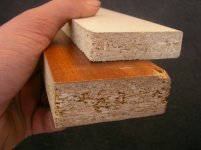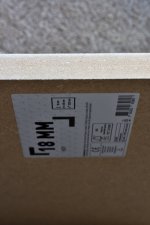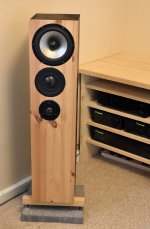The last kit I build was constructed of 22mm MDF (Vifa premium 11) a two way bookshelf design.
Each one weighs 9,9 kg and the inside is dampened with what I think it's called mass loaded vinyl. Heavy stuff from the diy speaker shop. It has a sticky back and glues to MDF. When carved with a knife it easily breaks along the cut.
All the speakers kits I build over the years are from MDF and are put together with just PVA wood glue. Most of them have fineer on the outside and none have fallen apart.
Each one weighs 9,9 kg and the inside is dampened with what I think it's called mass loaded vinyl. Heavy stuff from the diy speaker shop. It has a sticky back and glues to MDF. When carved with a knife it easily breaks along the cut.
All the speakers kits I build over the years are from MDF and are put together with just PVA wood glue. Most of them have fineer on the outside and none have fallen apart.
Can I buy you a pint sometime?
I'm trying foam for speakers, as I can't handle full sheets of anything else.
I'm trying foam for speakers, as I can't handle full sheets of anything else.
Last edited:
I'm trying foam for speakers, as I can't handle full sheets of anything else.
Closed cell or open? lol
Here’s a funny story for ya,
when we got to the insulation stage of building our house I decided to go with sprayed foam.
There’s two main decisions closed or open cell....closed has better R value per inch, and adds structural strength (much like a urethane glue) and costs twice as much but does not return the value as it’s only about 30% more efficient.
So we decided to use closed in the roof for added strength and open cell everywhere else.
Here’s the kicker, I thought the closed cell being denser would help quiet the unexpected popping/ticking sound the aluminum roof makes when expanding and contracting......wrong....I find out later after the wtf stage that closed cell foam can actually Help transfer certain sound...apparently!
Aaaaah....
Bob
Yes. Any combination that adds differentials to the equation will sum to an improvement I have no doubt. The choice of materials and the amount of differential (or improvement) is up to the designer. I have less faith in the choice of materials than in the implementation of the system. ie: I don't give a fat fart about what you make your box from even though I only use plywood (my choice). If it's thick enough and properly braced, you have so many things other than your wood to worry about. It's about #20 on the list.Is a combination of 2 materials better vs a only MDF or plywood?
in the US, there's a water resistant engineered flooring product by Avantech supposedly safer than some other stuff - wonder if it can be covered with Duratex?
in the US, there's a water resistant engineered flooring product by Avantech supposedly safer than some other stuff - wonder if it can be covered with Duratex?
Advantech? It’s some dense stuff, it comes covered with a waxy kinda film.....it can be sanded and painted I know that for sure.
You wanna talk heavy! 3/4” sheets of that by yourself wears one down!
Actually it looks kinda cool sanded then poly.
Edit.....apparently they make it in 1” and 1-1/8” ....interesting!
Last edited:
Here's what I use. 18mm MDF heavily braced, glued and screwed; fitted with an 18mm redwood front panel. No cabinet colouration whatsoever.
I learned my lesson about particle board years ago. Some of that stuff sings like the Diva Plavalaguna...
As for the dust - that's what dust masks are for 😉
I learned my lesson about particle board years ago. Some of that stuff sings like the Diva Plavalaguna...
As for the dust - that's what dust masks are for 😉
Attachments
It would need to be a link to a web page due to length and the number of figures plus possibly animations of detailed cabinet motion. The latter would make hosting relatively expensive and may not be practical.No background or info to offer, but a Sticky topic would be very nice! Especially the basics. And if possible some guidelines about panel thickness or a simple method to calculate problem area. Some rules of thumb would be nice. How to make a cheap vibrometer. I do hope you get cooperation.
I had intended to stick to mainly getting across the physics of what is going on and hence what works and what doesn't with hard evidence to back it up. I hadn't intended to develop design rules which become less useful once you opt to master quantitatively what is going on.
I have thought about similar things and concluded that neither FEA simulations or laser vibrometers are much good in quantifying the audibility of the problem.
This anti-knowledge, anti-science view is a common one among those with a practical inclination and a disinclination to take a significant amount of preparation time to learn about what is going on. So long as you have the resources and can maintain the enthusiasm while jumping from trying this to trying that with most of it not working as hoped it may work to a limited extent.
Instead, my recommendation would be to build a enclosure that has an enclosed driver on the inside. Only sound leaking through as panel vibrations will then be measured.
But it does lead to trying things like this which are too far removed from what is actually going to be representative. The lack of preparatory knowledge and understanding means this won't necessarily get recognised and lead to incorrect design decisions.
Pretty much in that it defines the two ends of the spectrum of how people may go about the research, development and design of something like a speaker cabinet. At one end a professional engineer would use the knowledge accumulated through years of formal training and experience to quantify and then optimise the various physical processes involved. At the other end we have people that don't possess that knowledge and don't know what is going on. They need to seek out guidance or design rules to follow. Where they look for that information varies in interesting ways particularly these days where technical expertise or a basic technical understanding of what is going on is increasingly considered unnecessary when seeking to get things done quickly and cheaply.Engineers or old wives...that's it?
Looking to what the professionals do for guidance can be wise but even here it requires an understanding of the objectives of those professionals. The larger German and Scandinavian pro companies are examples of good technical performance for reasonable cost but some of their manufacturing methods are significantly different to what we DIY folk can reasonably tackle in our garages. Most expensive home audio speakers on the other hand are often not a good guide in terms of technical performance for reasonable cost. Some are though but how would a person know which?What about pro sound? What they build and use has to be optimized for durability and performance.
If like the OP you are considering a speaker cabinet with 35mm thick MDF walls you won't find any examples looking to the larger established pro audio companies but you probably will looking to ultra expensive home audio companies. So who to follow if you feel that thick cabinet walls are the way to go?
What is the primary purpose for using two different materials in the structural layers? Cost?What's your take on having particle board as one of the layers of a CLD construction?
A cross section of the material I am talking about attached.
6mm ply + 12mm particle board + 6mm ply, layers bonded by a 2 part epoxy.
Having the stiffer material on the outside looks right in the sense of creating a stiffer composite panel.
The performance in terms of damping will follow from the appropriateness of the damping material and it's thickness plus the stiffness and thicknesses of the constraining layers. Given you seem to have performed no calculations to determine this sort of thing it is pretty unlikely you have specified something close to optimum.
Having said that, it may well be a noticeable improvement in terms of damping over a single panel of chipboard or ply of similar thickness. A single panel of ply will be stiffer though.
You may want to check out this video:
YouTube
Tech Ingredients - World's second best speakers
Clickbaity title, but the video is actually pretty good.
After a few seconds when he said that the two properties that prevent the panels moving are stiffness and mass I stopped watching (for a speaker like that with resonances within the driver passband damping is likely to be the most important property). Perhaps it was a mistake and there is good stuff elsewhere but skipping about it appears to be a windy video with no figures and diagrams which is not a good way to get across information about engineering.
But many thanks for the link because this is very much the type of stuff on the engineering of speaker cabinets that I am interested in and I will likely revisit it later when I have more time.
I know next to nothing about speaker design, but the relevant portion to this particular thread is somewhere in the 30min mark where he shows the difference between MDF and plywood using an accelerometer and an oscilloscope. How relevant that is to speaker building, I have no clue. The gist of the test is that there is not much difference between the two. I'm sure the speaker design is not that great and all that, but that was not the point. I found the test interesting.
I mean the same guy made some pretty cheesy panel speakers before and called them the best speakers in the world. Make what you will of that.
I mean the same guy made some pretty cheesy panel speakers before and called them the best speakers in the world. Make what you will of that.
OK Fred, off the top of my head, and in no particular order:Hey Cal give us at least the first 10 on your list!
Design
Midrange
Woofer
Tweeter
Crossover type
Crossover materials
Bracing
Amp
Source
Room treatment
The choice of, or implementation of all those are more important to the system and it's level of satisfaction than the cabinet's core material IMO.
So are:
Cabinet placement
Damping
WAF
Grille
dB potential
Joinery
Glue
Cabinet finish
Visual satisfaction for the builder
#20. Cabinet core material 🙂
If you subscribe (ascribe?) to ‘a chain is only as strong as it’s weakest link’ ......it’s all important.
Last edited:
- Status
- Not open for further replies.
- Home
- Loudspeakers
- Multi-Way
- Ply vs MDF


